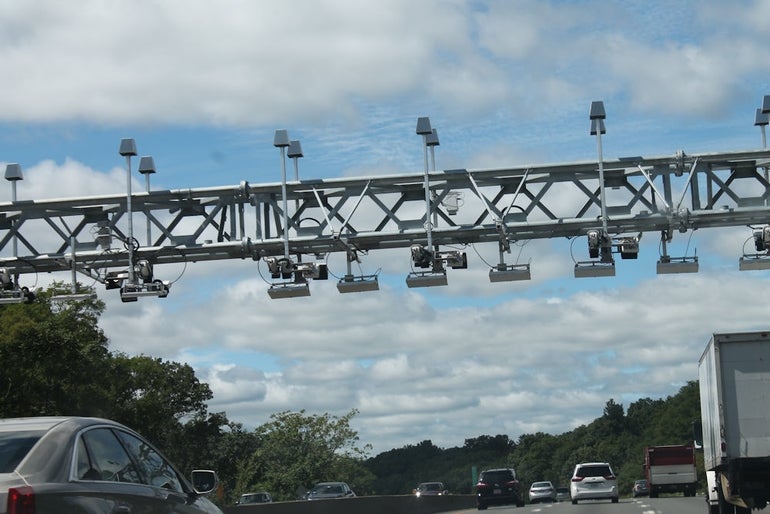With electronic eyes set to take the place of toll plazas, Massachusetts transportation officials have proposed a tiered payment system that strongly favors those who obtain transponders from the state.
The all-electronic tolling system set to go live Oct. 28 will provide a 45-cent discount to drivers traveling the entire length of the Massachusetts Turnpike who have obtained a free EZPassMA transponder.
For drivers who lack any type of electronic tolling transponder, the cost of driving from New York to Logan Airport will nearly double from its current $7.10 to $13.40 plus a 60-cent billing fee. For drivers without a transponder, tolls once dropped in a bin or handed to a toll-taker as cash will be handled by the U.S. mail.
“That choice is going to cost you money, because it costs us money,” Transportation Secretary Stephanie Pollack told reporters Monday, ahead of a Massachusetts Department of Transportation Board of Directors meeting.
Overall the state expects toll revenues to slightly decrease, dropping from $128.1 million to $127.7 million on the portion of the Pike from Weston westward, and dropping from $225 million to $216.3 million on what’s called the Metropolitan Highway System – encompassing the eastern part of the Pike, the Tobin Bridge and the harbor tunnels.
“This is not a toll increase. This is a rate-setting process,” Pollack said.
The rates presented Monday could be altered before a final vote Oct. 6, and MassDOT plans to hold seven public meetings around the state starting Sept. 6.
Rather than the old toll system of racking up charges with each exit, the electronic gantries that straddle the highway snapping photos of license plates will bill drivers at each gantry location individually.
Pollack said technology available in Raytheon’s electronic tolling system dubbed a “hot list” – which allows the gantries to look out for a specific license plate – would be used sparingly and the gantries would not be used to determine if cars are speeding.
The “hot list” could be employed in the case of an Amber Alert, Pollack suggested, or in a “very narrow set of immediate public safety emergencies.” Pollack said a policy framework could call for the secretary of public safety and security to request a vehicle be placed on the “hot list.”
Pollack also said the department would work to secure and ultimately dispose of data collected by the system, holding onto it only for the purposes of billing.
“There’s always a risk when you have data,” Pollack said. She said MassDOT only releases data to authorities under a subpoena; the subject of the subpoena is alerted and given an opportunity to quash it; and the department received 12 subpoenas last year.
Highway Administrator Tom Tinlin said the switch to all-electronic tolling would reduce congestion and pollution while increasing safety, as crashes are more prevalent around toll plazas.
The change will also increase disparity in who pays what to keep the highways in working order.
While those without any form of transponder will pay the most, racking up 30-cent fees on top of the toll at each gantry, drivers with out-of-state transponders will pay a total of 45 cents more across the length of the turnpike. Pollack emphasized that the EZPassMA transponders will not be limited to Bay State residents, using an example of a New Hampshire resident who uses Massachusetts roads frequently.
“The issue is not where you live,” Pollack said. The transponders, which are offered free to drivers, cost about $8 or $9 each to the state, according to MassDOT.
The rates developed by MassDOT before the public process would include discounts of varying size for EZPassMA drivers. The Allston-Brighton tolls right in Boston would be halved while others would be reduced by lesser amounts.
“We were not favoring any region of the state,” Pollack said.
Transportation officials have noted the location of the gantries – which absolve drivers in the areas of Springfield and Worcester making short turnpike trips from any tolls – were determined by the Patrick administration.
Tinlin said switching to the electronic system would save about $33.5 million in salary and benefits, though the new system incurs costs as well. In 2014, Raytheon received a $130 million contract for installation and 10 years of maintenance and TransCore received a 10-year $201 million contract for running the “back office” and seven customer service centers.
As the tolling switches to the gantries on Oct. 28 – a little over a week before the Nov. 8 election – workers will begin demolishing the old toll booths. Workers will start constructing driving lanes in the middle of the toll plazas, diverting traffic to the left and right, with a goal of completely converting the old toll plazas into highway ramps by the end of 2017.

